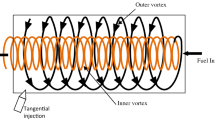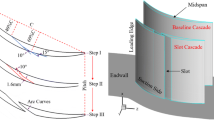Abstract
A research was conducted on a new mixing device referred as a “vent slot mixer”, using experimental and computational methods. The experiment was conducted in a laboratory-scale supersonic wind-tunnel of Mach number 2. Inflow air was under atmospheric air condition, and hydrogen gas was used as fuel. In addition, the computational simulation approach was performed to support the experimental result. The vent slot mixer can directly entrain the main airflow into the recirculation region, inducing complex flow structures in the recirculation region. This also leads to gradual development of the shear layer to reduce the total pressure loss mainly induced by a recompression shock. Contrary to typical shear layers of step mixer, for the vent slot mixer, two-dimensional large-scale structures and weak shocks were clearly identified around the shear layer through experimental and computational methods. When the fuel was injected from one circular injector in the recirculation region, the high fuel concentration of the vent slot mixer was evenly distributed along the spanwise direction, but with the step mixer the fuel was highly concentrated along the region downstream of the injector. Therefore, the vent slot mixer is effective to uniformly spread the fuel toward the spanwise direction in the recirculation region. As the fuel injection rate increased, the shear layer downstream of the vent slot mixer grew uniformly along the spanwise direction; consequently, shock structures such as a recompression shock and weak shocks on the shear layer were significantly mitigated at J = 3.2.
Similar content being viewed by others
Abbreviations
- F1 :
-
Switching function for Menter’s SST model
- J :
-
Momentum flux ratio
- k :
-
Turbulent kinetic energy
- M :
-
Mach number
- P 0 :
-
Total pressure
- P k :
-
Production of turbulent kinetic energy
- p :
-
Static pressure
- u, v:
-
x and y velocity components
- x, y, z:
-
Cartesian coordinates
- α:
-
Shock angle
- β, γ, σ ω 1, σ ω 2 :
-
Closure coefficients in the specific dissipation rate equation
- β*, σk:
-
Closure coefficients in the turbulent kinetic energy equation
- μ, μt :
-
Molecular and turbulent dynamic viscosity
- νt :
-
Kinematic viscosity
- Π:
-
Total pressure loss ratio
- ρ:
-
Density
- ω:
-
Specific dissipation rate
References
Charles, J.T.: An air-breathing launch vehicle concept for single-stage-to-orbit. In: AIAA-99-2730 (1999)
Edward T.C.: Scramjet engines: the first forty years. J. Propuls. Power 17(6), 1138–1148 (2001)
Seiner J.M., Dash S.M., Kenzakowski D.C.: Historical survey on enhanced mixing in scramjet engines. J. Propuls. Power 17(6), 1273–1286 (2001)
Roshko A., Thomke G.J.: Observations of turbulent reattachment behind an axisymmetric downstream-facing step in supersonic flow. AIAA J. 4(6), 975–980 (1966)
Loth E., Kailasanath K., Lohner R.: Supersonic flow over an axisymmetric backward-facing step. J. Space Rockets 29(3), 352–359 (1992)
Thakur A., Segal C.: Concentration distribution in a supersonic flow recirculation region. J. Propuls. Power 24(1), 64–73 (2008)
Gruber M.R., Baurle R.A., Mathur T., Hsu K.-Y.: Fundamental studies of cavity based flameholder concepts for supersonic combustors. J. Propuls. Power 17(1), 146–153 (2001)
Kalt P.A., Al-Abdeli Y.M., Masri A.R., Barlow R.S.: Swirling turbulent non-premixed flames of methane: flow field and compositional structure. Proc. Combust. Inst. 29, 1913–1919 (2002)
Driscoll J.F., Rasmussen C.C.: Correlation and analysis of blowout limits of flames in high-speed airflows. J. Propuls. Power 21(6), 1035–1044 (2005)
Thayer W.J., Corlett R.C.: Gas dynamic and transport phenomena in the two-dimensional jet interaction flowfield. AIAA J. 10(4), 488–493 (1972)
Coleman H.W., Steele W.G.: Engineering application of experimental uncertainty analysis. AIAA J. 33(10), 1888–1896 (1995)
Kobayashi K., Tomioka S., Mitani T.: Supersonic flow ignition by plasma torch and H2/O2 torch. J. Propuls. Power 20(2), 294–301 (2004)
Choi J.-Y., Jeung I.-S., Yoon Y.: Computational fluid dynamics algorithms for unsteady shock-induced combustion. Part 1: validation. AIAA J. 38(7), 1179–1187 (2000)
Won S.-H., Jeung I.-S., Parent B., Choi J.-Y.: Numerical investigation of transverse hydrogen jet into supersonic crossflow using detached-eddy simulation. AIAA J. 48(6), 1047–1058 (2010)
Menter F.R.: Two-equation eddy-viscosity turbulence models for engineering applications. AIAA J. 32(8), 1598–1605 (1994)
Hall J.L., Dimotakis P.E., Rosemann H.: Experiments in nonreacting compressible shear layers. AIAA J. 31(12), 2247–2254 (1993)
Dimotakis P.E.: Two dimensional shear layer entrainment. AIAA J. 24(11), 1791–1799 (1986)
Papamoschou D.: Structure of the compressible turbulent shear layer. AIAA J. 29(5), 680–681 (1991)
Huang L.S., Ho C.M.: Small scale transition in a plane mixing layer. J. Fluid Mech. 210, 475–498 (1990)
Anderson J.D. Jr: Modern Compressible Flow with Historical Perspective. McGraw-Hill, Boston (1990)
Kim J.-H., Yoon Y., Jeung I.-S., Huh H., Choi J.-Y.: Numerical study of mixing enhancement by shock waves in model scramjet engine. AIAA J. 41(6), 1074–1080 (2003)
Author information
Authors and Affiliations
Corresponding author
Additional information
Communicated by L. Bauwens.
This paper is based on work that was presented at the 22nd International Colloquium on the Dynamics of Explosions and Reactive Systems, Minsk, Belarus, July 27–31, 2009.
Rights and permissions
About this article
Cite this article
Kim, C., Sung, K., Jeung, IS. et al. Flowfield characteristics on a vent slot mixer in supersonic flow. Shock Waves 20, 559–569 (2010). https://doi.org/10.1007/s00193-010-0280-0
Received:
Revised:
Accepted:
Published:
Issue Date:
DOI: https://doi.org/10.1007/s00193-010-0280-0




